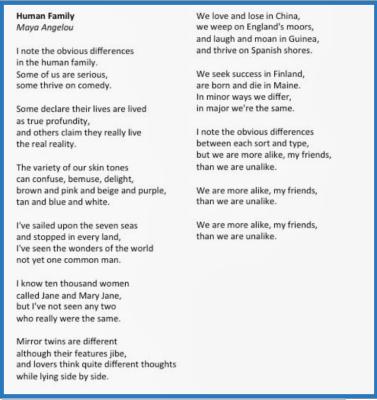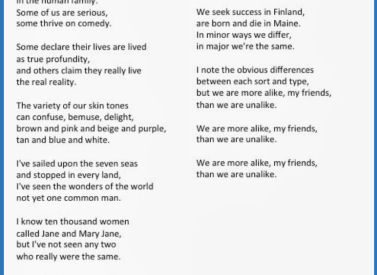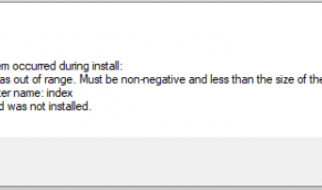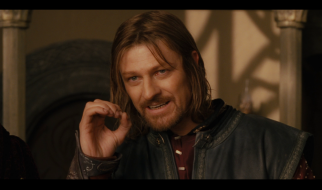
In Maya Angelou?s poem ?Human Family? she writes that there are differences throughout the human family, however we are more similar to one another then we are different. Angelou addresses a variety of minute differences that can be seen throughout the human family: personality, geographic location, appearance, and nationality. Throughout this poem, she mainly focuses on the differences that people have compared to one another, however at the end she seems to ignore these differences and comes to a realization that we are all actually more similar than different. The poem is written in mostly quatrains, with a rhyming pattern of ABCB, with eleven stanzas in total. By understanding the structure of the poem and the different topics it addresses, one can also understand the simplicity of the poem. There are different types of poems that will allude to certain ideas or demonstrate deeper, hidden meanings, however in Angelou?s poem she states simply that although there are small differences between people in the ?human family?, they must understand that they are more alike than unalike. There are two specific techniques that Maya Angelou uses, rhyming and repetition. First, the rhyming allows for a flow throughout the poem and ensures that all of the stanzas are moving towards the correct meaning. The rhyming also helps to occasionally further the idea of the poem by specifically making the rhyming words opposites of one another and therefore implying differences. Angelou uses repetition towards the end of the poem, when she repeats the line, ?We are more alike, my friends, than we are unalike.? By repeating this line, she is reiterating this idea and allows for the readers to conclude the poem with this one line and meaning in their head. It will possibly then allow for this idea to stay relevant within themselves. Maya Angelou uses a variety of techniques in this poem to demonstrate her beliefs regarding the differences among the ?human family.?
Along with being a poet and a singer, Maya Angelou was also a well known civil rights activist. During this time she started to become a serious writer and was joining writing guilds and societies. However, after she heard Martin Luther King speak she found a sudden calling to play a role in finding rights for all. Although there was not any specific event that triggered the creation of this poem, Maya Angelou was trying to spotlight the lack of civil rights that African Americans were experiencing. Like many other civil rights activists, Maya Angelou was working to create equality among the ?human family? and wanted to ensure that all people had rights no matter what race they were. This poem specifically addresses the differences among people from around the world. First, Angelou writes about how some people have different personalities, such as being serious or comedic. She then writes about the different skin tones that fill our world. Lastly, she discusses the different geographic backgrounds that people may come from. After addressing these small differences that people may have from one another, Angelou spotlights the idea of people being more similar to one another than not. By writing about the differences that people may have and then addressing the idea that those differences don?t matter and do not trump the similarities, she is bringing to light civil rights and equality. She is trying to cause people to ignore the differences and focus on the similarities. In this case, she wants people to forget about the differences in race or culture, and begin to understand that all people should be treated equally because as she said, people are so much more similar to one another then they are different.
Immanuel Kant believed that ?beauty exists in the mind, not the object.? He also believed that in order for someone to react to a certain piece of art and consider it beautiful, then it must stimulate their senses, emotions, and intellect. Maya Angelou?s ?Human Family? is beautiful to me because it made me curious, wanting to ask more questions, and it absolutely stimulated emotions. After reading this poem, the first idea that I was contemplating was the main idea that Angelou was trying to portray. After I understood that she was trying to teach the world about equality by addressing our minuscule differences compared to our abundant similarities, I was completely shocked. The way it is written is so beautiful, specifically in the way that it compares and contrasts the many aspects of our world. This poem made me think about the time in which Maya Angelou was writing it. She was a civil rights activist who was trying to reach equality throughout the world. When I knew more about Angelou?s background and her goals during this time, the message of the poem changed drastically for me. It no longer addressed the differences that fill our world in a negative way, instead it focused on the small differences and large similarities that could change our world for the better. This poem sparks three emotions within in me, sadness, inspiration, and hope. I first felt sadness as I understood that Maya Angelou had to fight for her equality and was working to have rights for herself and others. I was then inspired by the differences that she wrote about because after reading the poem multiple times, I just started to understand even more how small our differences are in the ?human family.? Lastly, along with inspired, I was hopeful. I was hopeful because society has moved closer to this goal of equality. Although I personally think we do have a ways to go before there is no discrimination and no stereotypes, I am hopeful that our society has changed since Maya Angelou wrote this poem. This poem gives me pleasure because it?s message helps to bring light to the issues that our society is facing today. By writing about the small differences that fill our world, and then including that we are ?much more alike than unalike,? it demonstrates very well that we are quite similar and have similar hopes and goals for the world.


